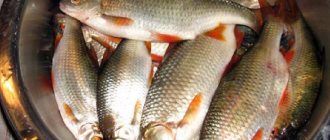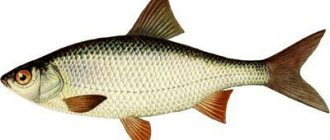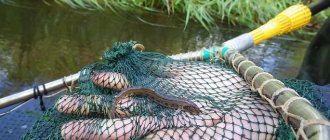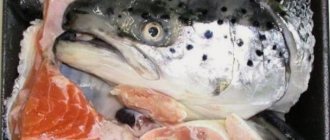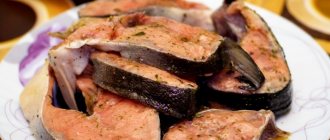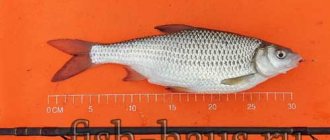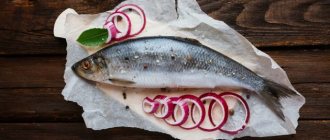Appearance
Roach has almost the same appearance as roach. The first photo below shows a common roach, and the second photo, which goes right after the first, shows a roach. The only difference that stands out is the size. The roach can grow up to 30 or even more centimeters in length.
The fish has fairly large scales: from 40 to 45 scales are located on the lateral line. Its mouth is located at the end of the muzzle. The beginning of the dorsal fin is located directly above the base of the ventral fins. All fins are painted gray. They have a black edge.
The back of the roach, like that of the roach, is almost black. But it casts green or blue. The fish has silvery sides and belly. There are dark spots on the silvery iris of the eyes above the pupils themselves.
What are the differences between them?
Distinctive features of the roach are gray fins with black edging. The eye color is silver, the iris is decorated with black spots. The average size of individuals can reach a length of about 30 cm with a body weight of 800 grams. A good bait is a dung worm. He will not refuse maggots, semolina, pea porridge and pearl barley. Canned corn is an excellent bait no matter the time of year.
We recommend watching a very useful video about roach and roach:
Distribution and lifestyle
Vobla is a roach that lives exclusively in the waters of the Caspian Sea. Within it, several large schools of fish can be distinguished:
- The Turkmen herd lives in the south-eastern sea area;
- The Azerbaijani herd feeds in the southwestern and southern regions of the sea;
- In the north of the Caspian Sea, the North Caspian herd of roach is widespread.
In winter, the fish remain in the sea: for this purpose, in the fall, their herds rush to the coast near the mouth of the Volga, where large wintering pits are located. River roach never winters in these places. With the beginning of spring, rarely at the end of February, the roach leaves the wintering pits, while other fish are still in a torpor, and goes to the rivers. The time of sending individuals from pits to rivers depends on weather conditions. If the weather is cold, the move is delayed, but when there is wind coming from the sea, the move begins earlier.
Individual specimens of roach can be found even in winter. But at the end of February she is already going to school. The movement becomes more active with the onset of the first days of March, and its peak occurs in April, when the surface of reservoirs is already free of ice. Schools of fish rush into all the tributaries of the Volga. But it was not observed that the roach rose above the city of Volgograd.
The bulk of the roach stops at river mouths, near which individuals look for places ideal for spawning grounds. In search of places for spawning, the fish swims at high speed at a sufficient depth (if the current is strong, then it swims along the shoreline). During the spawning run, many fish die. She may accidentally throw herself out of the water. And sometimes individuals die when the water quickly drains.
After the spawning period, the roach begins to actively feed: the food is exclusively of animal origin. Its attention is attracted by sedentary invertebrate organisms. By the beginning of winter, the fish becomes plump, fatty, its body is covered with a thick layer of mucus, which is designed to protect the body from hypothermia. Individuals lie down at the bottom of wintering pits near the mouth of the Volga, where they will remain in a half-asleep state all winter. In winter, the roach does not feed.
Lifestyle
Vobla belongs to the semi-anadromous form of roach and is one of its subspecies, which spends most of its life in the coastal regions of the Caspian Sea. All summer long, the roach feeds in shallow sea waters rich in food, and with the onset of autumn frosts it approaches the mouth areas of rivers and disperses in the area of the deepest holes. When the water temperature drops to 7 degrees, sea roach loses its activity and falls into a state similar to suspended animation. During hibernation, her body is covered with a thick layer of mucus, which provides protection from blood-sucking sea bugs and maintains a stable body temperature.
As spring approaches, sea roach begins to return to activity and rises upstream in the rivers flowing into the Caspian Sea. The first individuals begin to appear in rivers long before the ice melts. By the end of February - beginning of March, half the roach population is in the rivers. The most massive entry of fish into rivers occurs when the water warms up to 10 degrees. This period usually occurs at the end of March - beginning of April, one to two weeks after the ice melts. Trying to quickly get to the spawning grounds, the roach enters all the numerous Volga channels. The upper limit of roach migration up the river is in the Volgograd region.
The presence of a V-shaped notch on the anal fin is one of the main differences between roach and roach.
Roach fishing in April
During spawning itself, sea roach completely stops feeding. Her vitality is maintained by the fat reserves she acquired while climbing up the river.
The desire of the fish to stock up on a large amount of fat before spawning makes it grab any living creature while moving to the spawning grounds. This is precisely what explains the active bite of roach on fishing gear in the spring. The earlier an individual entered the river, the greater its chances of successful spawning. A significant part of the population does not rise up the Volga, but remains in its estuary areas, where they lay eggs. However, on the Volga rivers there are quite a few areas suitable for spawning, so roach is stuffed in large quantities into places suitable for spawning:
- shallow waters overgrown with reeds;
- shallow channels;
- backwaters;
- eriki.
The next fish to spawn rises along the Volga channels at a fairly high speed, while sticking to the central part of the river. If the current is too strong in some area, then schools of sea roach are pressed to the shore, where the pressure of the water flow is less noticeable.
For spawning, the fish chooses well-warmed shallow areas with standing water, where the depth does not exceed a meter mark. A significant part of the roach is doomed to death after spawning, since the water level drops rapidly after a flood and all shallow areas remain cut off from the main river bed and gradually dry up. Around such natural dining areas, many fish-eating birds and animals always gather, wanting to profit from trapped fish. A significant part of the sea roach population dies at sea when strong waves wash ashore weakened individuals returning from spawning.
Like most carp fish, the roach acquires a nuptial plumage before spawning. Small white growths appear on her head, and her scales become rough to the touch. The entire body is covered with thick whitish mucus. After spawning, sea roach loses a lot of strength. Her body uses up all its reserves of subcutaneous fat, and the fish becomes very thin. The roach's body becomes narrow and acquires a darker color. Exhausted from spawning, she returns to the sea. During the return journey, the fish no longer form large schools and go to their permanent habitats separately.
Spawned individuals are not of interest to fishermen, since their meat has low taste.
Reproduction
As mentioned above, the roach begins its spawning run at the end of winter or early spring. As spawning grounds, the fish chooses not only the mouths of rivers and streams, but also ilmen, backwaters, channels and eriki. She loves places overgrown with reeds and other vegetation that have been filled with hollow water. The ideal place for roach spawning is shown in the photo below: spawning occurs here.
During the spawning run, the roach changes its appearance, as happens in other migratory forms of representatives of the ichthyofauna. Long before the start of spawning, the outer integuments of the individuals begin to actively work. At the same time, a lot of mucus is released, which covers the entire body and becomes very thick. In female and male individuals, white warts form on the body, right on the scales, which subsequently not only darken, but also acquire a sharp, hardened tip: you can see them in the photo below. The photo also shows that the fish’s head is covered with large whitish tumor growths: this is what the roach’s mating plumage looks like.
The roach stops feeding during the pre-spawning period. During the entire spawning period, her stomach is either empty or filled with mucus. The roach lives during the spawning period only from fat reserves that remain from last year. Therefore, during early spawning, roach has more fat than during late spawning. After the belly of the fish is empty of milk and caviar, the body becomes so skinny that it becomes half the thickness of the head: it becomes elongated, narrow, dark, as in the photo.
After the end of spawning, the roach goes back to the sea, where it begins to greedily rush at its prey. It returns back no longer in shoals; at this time it is called rolling. Vobla cannot be found in rivers from the second half of May, and this will remain the case until the next spawning begins. The roach fry that hatch from the eggs immediately go into the Caspian Sea, where they will live until they reach sexual maturity. During its entire life, the fish manages to spawn 5 or 6 times.
Vobla is a fish loved by everyone who drinks beer. Dried, dried and smoked roach is a delicious dish and snack. Therefore, roach fishing occurs on an industrial scale, but fishermen themselves like to catch and dry it themselves.
tutryba.ru
In Kuban, we call taranka salted and dried Azov fish. To be precise, the ram is a Black Sea-Azov subspecies of anadromous roach. In the spring, the ram, overflowing with eggs, enters the rivers from the estuaries, where it is caught en masse by both fishermen and amateurs. The ram reaches a length of 60 cm and a weight of up to 2.2 kg. During Sabaneev’s time, the ramming movement was especially widespread; this fish was very cheap and, accordingly, popular among the poor population. Especially in salted and dried form. This is how the name of the subspecies of fish became the general name for the method of its preparation - ram.
Roach *** CAUTION FAKE BY GOD as a ram - this is also a subspecies of roach, leading a semi-anadromous lifestyle but in the Volga delta basin and in the Caspian Sea. In spring it rises into rivers to spawn. Reaches a length of 35 cm and a weight of about 800g. It eats almost the same as other roaches . The roach reproduce so prolifically; it spawns about 5 times in total during its entire life. Eggs are deposited no deeper than 50 cm. Roach occurs in April – May. During spawning, the spring appearance of the roach changes. A mating plumage is formed, so to speak, growths appear on the gills and head, and are covered with a fairly thick layer of mucus.
The difference between taranka and roach is the fat content. Taran is fattier, larger, tastier (1,000,000,000 times) due to the fact that in Azov and the estuaries there is such a worm, which in the Kuban is called “humus”. THAT'S WHAT SHE FEEDS ON. But the Volga and Caspian Sea do not have it or it is less fatty. There is little real ram today even in Krasnodar, Grivenskaya, Primorsko-Akhtarsk, Temryuk and other large fish markets, because it was caught by crests godlessly and lawlessly from Azov, and now sellers often buy Volga roach and pass it off as ram. It is rare to buy a real ram, or very expensive from 1500 to 5000 rubles. for a dozen, or a small size and only from fishermen, for example in the Prigibsky farm...
Taran is salted only in brine - a solution of salt in water until saturated (an egg floating halfway). The dry method is for roach or bad upbringing...
1. Never wash your hands before cleaning the ram! 2.
It’s too early not to start clearing until the beer has been poured and the company has not sat down at the table, in addition, I will repeat the axiom (repetition is the mother of learning) - do not start drinking beer until you have poured vodka three times - THIS IS A MANDATORY CONDITION for the meal! 3. When all of point 2 has been completed, take the ram (under no circumstances should you hit it on the table or on your neighbor’s head, these are signs of poor upbringing and cutting a roach as dry as plywood) and begins the meal with the fins near the head. We carefully tear them out using a gentle twisting method, gnaw them while sipping beer.. 4. Next, we get into the “taste”, a conversation ensued - we tear off the anal fin of the ram tangentially, so as to remove as much of the “skin” as possible with it up to the dorsal fin, all this it is done softly, smoothly (don’t forget to sip beer!) When the skin is gently removed to the dorsal fin, we take the dorsal fin along with the skin and remove the skin on the back side of the ram. Without bragging, I will say: I know how to remove the skin from the battering ram completely (100%) at one time - entirely!!!. With some skill, you will first learn to clean most of the ram with this movement (from the anal fin to the dorsal and then on the reverse side...) while simultaneously removing part of the insides - the insides are finally pulled out with the same unwashed fingers...). But of course your hands should be clean from the beginning, everyone understands what I mean. Not surgically clean, but simply - like ))))) before eating... 5. All that remains is to clean the scales at the head and tail - and here it is - a ram, like a naked bride in front of you.. 6. Now you can wash your hands and indulge in the meal and have a nice conversation!
Under no circumstances should you cut off the back of the ram with a knife or cut the ram into pieces, this is disgusting, it spoils the taste, this is not Christian. Taran, like bread, must be broken and separated into pieces by hand...
harpoonerwhaler.livejournal.com
Fans of fish products, sparing no effort, argue about whether roach and ram have differences in taste, method of preparation, appearance and other features.
Only true experts can immediately tell what the difference is between the varieties of fish product - ram and roach. In fact, both of these fish are nothing more than roaches
.
Roaches usually live in freshwater bodies of water. If she has enough food, and she eats plants, insect larvae and mollusks, then her habitat will remain unchanged. With a meager diet, the fish begins to migrate in search of profit and often gets out of a freshwater reservoir into sea waters (the pre-estuary part of the river). Ram and roach: the difference in fishing Roach that spawns in fresh waters and feeds in desalinated waters is called semi-anadromous roach. This fish caught in the Caspian Sea basin will be called roach. fishing for semi-anadromous roach in the Black and Azov Seas is already a ram.
Such species of fish grow and develop faster than ordinary freshwater (live) roach, which does not go beyond the traditional spawning site. It is worth saying that roach, ram and roach gather in schools of fish before spawning, which makes fishing easier. Preparation of salted fish Vobla and ram differ not only in habitat, but also in size, that is, in morphological characteristics. Roach, for example, is larger than ram and even more so roach. Despite the external differences, these types of fish are prepared according to the same recipes. Traditionally, this fish is salted, dried and dried, while ram gave the name to the entire assortment of small-sized salted dried fish - ram. Consequently, this pseudo name can hide a ram, a roach, and the same roach. It is better to salt this fish in a dry way, that is, rub it with salt. Small fish are only cleaned of scales (and even then not always), half-kilogram carcasses are better cleaned of entrails. Place the grated fish carcasses in rows in a wooden container and sprinkle thoroughly with table salt. The fish will be salted in a refrigerated room for at least two weeks. Larger carcasses may require more for salting. At room temperature, pickling time is a week. Dried fish Before salting the fish, it is allowed to dry for several hours. Then they are treated with salt, as with dry salting, strung on a fishing line through the eye sockets (small fish can be collected in bunches of several pieces) and soaked in a saline solution for two days. By the way, if you dry fish in the summer, then the salting time in the solution is no more than a day. Subsequently, the ligaments are removed and washed with water. weigh the fish in an open, well-ventilated place; you can cover it with gauze to protect it from insects and dirt. Dried ram will be ready in 2 weeks. Please note that in summer you need to monitor the fish more closely, as a product exposed to the sun may become bitter. Vobla and ram: fish or method of preparation As in the case of the name “ram”, many consumers of fish products think that “vobla” is nothing more than the name of a dish, not a fish. Most likely, this opinion was formed due to the fact that recently fishing for roach has decreased significantly. The unsightly living conditions for this species of fish have contributed to a sharp decline in the roach population. There is absolutely no difference in the preparation of ram and vobla. But for some reason, true connoisseurs of dried fish believe that roach is much tastier than ram. This post was edited by u1976
— 16.04.2016 — 19:27
www.yaplakal.com
Dried fish
Before salting the fish, it is allowed to dry for several hours. Then they are treated with salt, as with dry salting, strung on a fishing line through the eye sockets (small fish can be collected in bunches of several pieces) and soaked in a saline solution for two days.
By the way, if you dry fish in the summer, then the salting time in the solution is no more than a day.
Subsequently, the ligaments are removed and washed with water. Hang the fish in an open, well-ventilated place; you can cover it with gauze to protect it from insects and dirt.
Dried ram will be ready in 2 weeks. Please note that in summer you need to monitor the fish more closely, as a product exposed to the sun may become bitter.
What is the difference between roach and rudd, roach and ram?
Roach, rudd, roach and ram are species of fish of the carp family. Despite their external similarity, these fish have significant differences. To find out what the difference is between them, we suggest you read the information from our article.
- The roach is a small fish whose body length is about thirty centimeters. The fins of the roach are gray in color, and there is a dark edging along the edges. In winter, the body of the fish is covered with a thick layer of mucus, which protects the roach from the cold. The habitat of the fish is mainly the Caspian Sea, but closer to the beginning of spring the roach migrates to rivers. Before the start of the spawning period, the fish stops eating and lives off the fat accumulated over the winter. The roach's diet consists of invertebrate animals. From the end of May until the beginning of spring next year, this fish cannot be found in rivers, since after spawning it returns to the sea.
- The rudd is distinguished from other fish species by its bright color. The body of the rudd is golden in color, and the fins have a red tint. The eyes have an orange iris. The more mature varieties of rudd have the most saturated color of the body and fins. The habitats of the fish are the Azov, Black, Caspian and Aral seas. Rudd can also live in artificial reservoirs, preferring places with a lot of reeds. Having chosen a place to live where underwater vegetation will be abundant, this fish does not change it. The body length of the rudd reaches forty centimeters, but specimens up to twenty centimeters are usually found. This fish does not like currents, so it prefers to spawn in quiet creeks and reservoirs, starting from May and ending in July.
- Roaches are highly active throughout most of the year. This species includes many subspecies, including ram, roach and soroga. In appearance, the roach resembles the rudd, but its color is less saturated. The lower fins are red, and the tail and dorsal fins are close to brown. The back of the roach is dark with a bluish tint, and towards the belly the color changes from yellowish to silver. The diet of this fish consists of invertebrates, and at a young age - algae. Roach spawns in large flocks, preferring closed reservoirs or bays. For the winter, the fish descend into deep holes, and their activity decreases until the beginning of March.
- Taran looks very similar to roach and rudd, but has differences. The ram's fins are marsh-brown in color, and the body has a golden color that turns dark towards the back. The fins are slightly larger in size compared to other species of fish of the carp family. The average size of the ram is thirty-five to forty centimeters, but most often you come across individuals no more than twenty-five centimeters in length. This fish lives in the Azov and Black Seas. It can go into rivers adjacent to the seas to spawn, but it never goes far from its main habitat. Taran also differs from other cyprinids in that it can quickly adapt to new living conditions, thanks to which it easily finds food in new places. It feeds mainly on small crustaceans and sometimes vegetation.
From all of the above, we can conclude that there are not only external differences between roach, roach, ram and rudd. These types of fish also differ in their habits and habits, so if you are planning to go fishing, the information from our article will not hurt you.
Roach
The roach's habitat is rivers and lakes, including Europe and Siberia. It is mainly found in calm water, where there is practically no current. The largest individuals can reach a size of 45 cm in length and have an average body weight of 1.5-2 kg. They go to spawn when the water warms up to a temperature of at least ten degrees. Roach is a fairly common type of fish in our country, along with ruffs and perches. It feeds on worms and insect larvae. Enjoys eating mollusks and crustaceans. Willingly eats green algae. She is extremely rarely hungry, since there is always food.
This type of fish has a capricious disposition and can deceive even an experienced fisherman. The cunning individual does not attack the bait, trying to swallow it. First, he tastes the treat. Quickly recognizes deception. It only takes a split second for her to spit out the bait she doesn’t like. Roaches mainly bite on worms, bloodworms, maggots, caddis flies and bark beetles. As homemade preparations for fishing, you can use bread crumb, dough, pea, semolina or pearl barley porridge.
In the spring, when the water becomes cloudy and “blooms” in places, some species of river inhabitants experience problems: “stomach churning.” Due to indigestion, they refuse to eat for some time. Roach is not one of them. If it doesn’t bite well in muddy water, it means it’s quite full. If attempts do not lead to success, it is better to abandon the idea. You will waste your time and there will be no catch.
You can catch roach at any time of the year. In the spring, shortly before spawning, is the best time. Before spawning, the bite weakens and for ten days after it the fish will not bite. In summer you can count on a good catch at night or early in the morning. The pre-dawn hours are the best. In spring, the bite will continue throughout the day. In autumn and winter, it is preferable to go fishing in the evening in order to return home with a rich catch. The roach has a light gray body and fins. A gray-brown tint is noticeable on the back, the sides and belly are silvery with a brown tint.
The post Roach and roach - the main differences appeared first on Cool fishing.
Share on social media networks
0
Author of the publication
offline 1 hour
Fishing with roach
Vobla fishing is one of the favorite pastimes of young and experienced fishermen. If you are going to go fishing for roach, then it is best to fish in late April or early May, when roach activity is highest. You will need the necessary gear, bait, and also a little theoretical knowledge about this fish. We invite you to study our article to take note of useful information, as well as watch an interesting video.
Spring is the best time to catch roach. The fish comes to the surface when the water temperature reaches six degrees. Until this moment, the roach overwinters in deep holes, which is why winter fishing for this fish will not bring impressive results.
In March, the roach bite begins when the ice has already melted. Bloodworms and maggots should be used as bait. Since after wintering the fish are hungry, feeding is not required, but at this time the roach is inactive. You can catch only two or three fish in a few hours, so if you are not setting a good catch as your goal, going fishing just to relax, this option is suitable for you.
In April, a full-fledged bite begins, during which you can use any type of gear. Vobla is perfectly caught with a regular fishing rod, as well as with donks and feeders. At the beginning of the month, it is better to go to wide rivers, using earthworms and dung worms as bait, and by the end of April it is advisable to move to small bays.
When the water temperature rises to twelve degrees, the roach will live close to the shore, so the fishing rod should be cast no further than fifteen meters. In this case, weather conditions must be suitable. The sun must be bright, and a light breeze will also be useful. You can use crackers and millet as bait to lure fish closer to the shore.
If you still decide to go winter fishing, then you should go to shallow water areas, drill an ice hole and use a light fishing rod. Bloodworms and corn should be used as bait. Don't forget to bring a quality tent, as it can get quite cold near the water in winter.
Periods and places for catching rams in winter
Morning dawn and evening are the most suitable periods for fishing for ram, although sometimes this fish is caught recklessly all day, preferably a gray one, without the sun. The ram roach takes over on such days with some weakening and increasing activity. In addition to river mouths, schools of these fish are most often found in muddy estuaries, rich in various shells and crustaceans, especially near reed thickets, even if the place is shallow. But even in deep holes, along their edges, you can find excellent rams, and even in such places up to ten meters deep, rams gather in flocks closer to spring.
How to choose?
When choosing a roach, pay attention to the eyes; they should not be cloudy. The scales should fit snugly to the body. There should be no mucus on the clean surface. The body should be elastic and when pressed, the shape should be restored.
You need to choose roach in a store or market correctly so as not to buy a low-quality product and not cause harm to your health. We recommend that you take note of a few tips on choosing fresh and dried fish.
- When choosing dried roach , pay attention to its scales. It should be shiny and dry. The scales should also be free of white plaque, spots and damage. The smell should not contain any foreign impurities. Also make sure that the roach is completely covered with scales. If there are not enough scales in some places, it means the fish is not the freshest. In addition, when purchasing, inspect the product, paying special attention to the abdomen and gills. Under no circumstances should there be moisture in these places, and if there is moisture, this means that the fish is stale and was previously soaked in a solution to remove unpleasant odors.
- Dried roach should also have no damage to the body, all scales should be intact, and there should be no spots on the fish. Foreign odors are unacceptable. A good product stands out from others by the rib bones protruding from the belly, as well as intact fins. If you want to select a fish with caviar, feel the belly. It should be elastic and convex. The meat of dried roach should not be as hard as dried roach, especially on the back. Particular attention should be paid to cutting fish, since at this stage worms can be detected in the meat. In this case, it is better to throw away the spoiled product.
- Fresh roach should also be selected carefully. First you need to lift the gills and smell the fish. There should be no other smell other than sea and mud. Fresh roach does not even have a characteristic fishy smell, so take this fact into account when choosing a product. The scales of a fresh roach should be smooth and moist unless the fish is frozen. Cracks and defects on the carcass indicate that the product was stored incorrectly and it may be spoiled. The gills are bright red or pink, and the eyes are bulging and transparent.
Do not hesitate to ask the seller for a quality certificate, which will confirm that the products have indeed passed the necessary tests and are suitable for consumption. Also, when choosing a roach, follow our recommendations to buy a quality product.
Ramming baits and lures
Like roach, which, although not everywhere, is caught from the ice on dough, semolina and bread, ram also pecks from the ice on bread baits and various boiled cereals. Ram fishing dough is usually colored pinkish-red. For this, food coloring is used. But the most popular of the baits can be called the traditional bloodworm. Also, this fish will not refuse maggots and worms. And they use colored maggots. The color is also pink-red. A popular attachment is also semolina mash, which in some cases competes with bread crumbs. Boiled pearl barley in some cases and especially during the pre-spawning period is also an effective bait.
Maggot for fishing
Bloodworm for fishing
Worms for fishing
Burbot of the small river
Beneficial features
The benefits of roach are primarily due to the presence of a large amount of protein in it. Fish also contains polyunsaturated fatty acids, which are beneficial for the body, as they reduce the risk of cardiovascular diseases.
Wobbles contain B vitamins, which are necessary for muscle tissue, the nervous system and the entire body as a whole. Fish contains ascorbic acid, which is needed to maintain immunity, as well as for skin health and normal brain activity.
The presence of chlorine and sodium ensures the normalization of water-salt balance. Voble also contains phosphorus, which is involved in the regeneration of bone tissue, and together with calcium, it strengthens it and improves the condition of hair, teeth and nails. Fish contains molybdenum, which is necessary for metabolism, and it also improves sexual function.
It is also worth mentioning that roach is low in calories, so it can be consumed without fear of spoiling the figure, as well as for people who suffer from obesity.
During pregnancy and breastfeeding, it is very useful to eat roach, since this fish contains a large amount of protein, as well as vitamins B and C, which are necessary for a woman’s body when she is bearing and feeding a child. Also, wobbles contain a large number of other microelements, such as phosphorus, potassium, calcium, sodium, as well as molybdenum and many others.
Due to the fact that the calorie content of roach is no more than one hundred kilocalories per hundred grams of product, this fish can be included in the daily menu of people who are on a diet. Soups with roach fillet, as well as the inclusion of other seafood in the diet, will be useful. However, you should not overuse fish, as in large quantities it can cause bloating and nausea.
Roach caviar also has beneficial properties for the body, as it improves the condition of the hair and helps cope with various types of skin rashes. Various cosmetic products are made on its basis, which will be especially useful for women over 30 years old, as it has a stimulating effect and slows down the aging process.
Use in cooking
Roach is not as popular in cooking as other types of fish. Most often at home it is salted, dried or smoked. Some people like to eat this fish fried. I use not only fish meat for food, but also caviar. Vobla can also be subjected to other heat treatment: a very popular dish is stewed roach in milk. It can also be boiled and used for preparing first courses.
You can prepare roach in many different ways. Most often it is salted by soaking it in brine or brine. We will tell you how to do this a little later in our article.
You can also soak the fish if it turns out too dry. The situation can be saved if you soften the fish using our recommendations. To do this, you will need clean cloth towels and plain water. Moisten the cloth so that it is damp but not wet, and wrap the dried roach in it, then put the product in the refrigerator for twenty-four hours. After this, the roach should become much softer, and if this does not happen, repeat the procedure, leaving the fish in the towel for another twelve hours, after moistening the fabric.
It is also necessary to clean the roach correctly. To do this, follow our recommendations:
- To begin, take the fish in your hands and knead it thoroughly, bending it in different directions so that the scales and skin separate from the meat and bones.
- Then grab the anal fin with one hand and pull it towards the fish's head to tear off the abdomen along with the pelvic fins.
- Cut off the head of the roach using a sharp knife.
- Also clean the insides of the roach with a knife. If there is roe in the fish, remove and clean it.
- Now you need to remove the skin and scales. This will be very easy to do if you have previously kneaded the fish. Simply pry the edge of the skin at the base of the head and pull it towards you, thus cleaning the entire carcass of the roach.
- After this, the dried or dried fish will be ready to eat. You can cut it into pieces or tear off the meat with your hands.
You can pickle the roach yourself at home if you are lucky with your catch while fishing. We will talk about this in the next subsection.
How to pickle?
Pickling roach yourself is quite simple. To do this, you need to prepare brine or use regular salt. There are also several recommendations that will help you organize the salting process correctly.
- It is not recommended to wash or clean fish before salting. If there are remnants of mud or river debris on it, you should remove them with your hands or with a napkin.
- It is advisable to use coarse salt, since a finely ground product will contribute to the formation of a salt crust on the fish carcass, due to which the roach meat will not be salted well enough.
- It is always necessary to put pressure on top so that the salting process goes faster and the fish does not have time to spoil.
- After the roach has been in the brine for the required time, it needs to be transferred to cool water for a couple of hours to remove mucus and plaque. Poke fish will look more appetizing.
Now we can proceed directly to the salting process. To do this, you will need coarse salt, a roach, an object for pressing (you can take a pan or a bottle of water) and a large container. If you are going to salt fish for drying, then you will need brine, or brine. We will talk about salting roach for drying in the next subsection, but now you need to stock up on regular salt.
Place a layer of rock salt on the bottom of the selected container, and then place the roach on top so that the largest fish is at the bottom. Sprinkle a layer of salt on top again, transferring it to smaller roach. Do this until the fish is gone. The last thing should be an impressive layer of salt. Now you need to cover the container with the roach with a wide lid and leave to infuse at room temperature. Twelve hours later, when the fish releases juice, place pressure on top and put the entire structure in a dark place where it will be cool enough. After two days, the salted roach should be rinsed with water and left to dry on a clean towel, after which the product will be ready for use.
How to dry?
You need to dry the roach at home after you soak it in brine or brine. To prepare it, you need to take two hundred and fifty grams of salt per liter of water, mix it all in a small saucepan and bring the mixture to a boil. After this, cool the brine and check the strength by dropping a raw chicken egg into it. It should float on the surface; if this does not happen, it means the brine is not strong enough. Add a little more salt so that the egg stays on the surface, after which you can start salting the roach.
You need to take small fish, which must be fresh. The roach must first be strung on a strong rope, threading it through the eye and catching the free end through the mouth opening, and then lowering it into the brine so that the liquid covers the fish completely. Leave the container with brine and roach for two days, then remove the fish and hang it over the container to drain. When the brine stops flowing, you should hang the roach in a well-ventilated area or outside, covered with an insect net. After the product has dried to the desired condition, you can remove it and eat it.
How to dry?
It is best to dry vobla in autumn and spring, since at this time the fish contains the greatest amount of fat, which makes the product tastier. In this case, it is better to take a small-sized roach, because it will salt better and also dry faster. Preliminary cleaning is not required; it will be enough to wash each fish from dirt and also wash off the mucus from it.
Now you will need a large, deep container. Place a layer of salt on the bottom and top it with fish, then salt again and fish on top. Continue to do this until the roach runs out. The last layer should be salt.
After ten to twelve hours, the fish will release juice. After this, it should be covered with a lid and a bend should be placed on top. The roach should be under it for at least two days, after which it is necessary to string the fish on threads and hang it to dry in a well-ventilated place.
Where and how to properly store it at home to prevent it from drying out?
At first glance, it may seem that you can store roach at home for a very long time, but if stored incorrectly, it can dry out. To prevent this from happening, you must adhere to simple rules, which we will discuss in our article.
- If you need to store dried or raw roach for a long time, it is best to do this in the freezer . To do this, the fish should be wrapped in cling film or a plastic bag and placed in the freezer. After defrosting, the dried roach will need to be dried a little. You can also store the product on the bottom shelf of the refrigerator, but this option is not suitable for raw fish and is less durable.
- Another option for storing dried roach is glass or plastic containers . A little medical alcohol is poured into the bottom of the container, after which dried fish is placed in the container. You can also do without alcohol if you take a glass container and throw a lit match into it so that all the oxygen burns out. Then you should fill the container with fish and roll up the lid, storing it in a dark, dry place.
- If you want to store the fish for no longer than a month without allowing it to dry out, you can leave it hanging in the same room where it was dried. In thirty days the roach will not dry out much more. If you are still worried, you can spray the product with drinking water from a spray bottle once a week.
- You can also use large wooden boxes to store fish. Making them yourself is not difficult. To do this, you need to take thin leaves of plywood and make a box out of them, inside which you will equip fastenings for hanging fish. Holes for ventilation should be made in the walls of the box, and the outside of the box should be covered with gauze to protect the fish from insects. In this way, you can store dried roach from a month to three.
By following our recommendations, you will be able to properly salt roach, and also learn how to store and catch it. At the same time, do not forget that it is advisable to cook fish that was recently caught, since in this case the product will be more aromatic and will have a rich taste.
